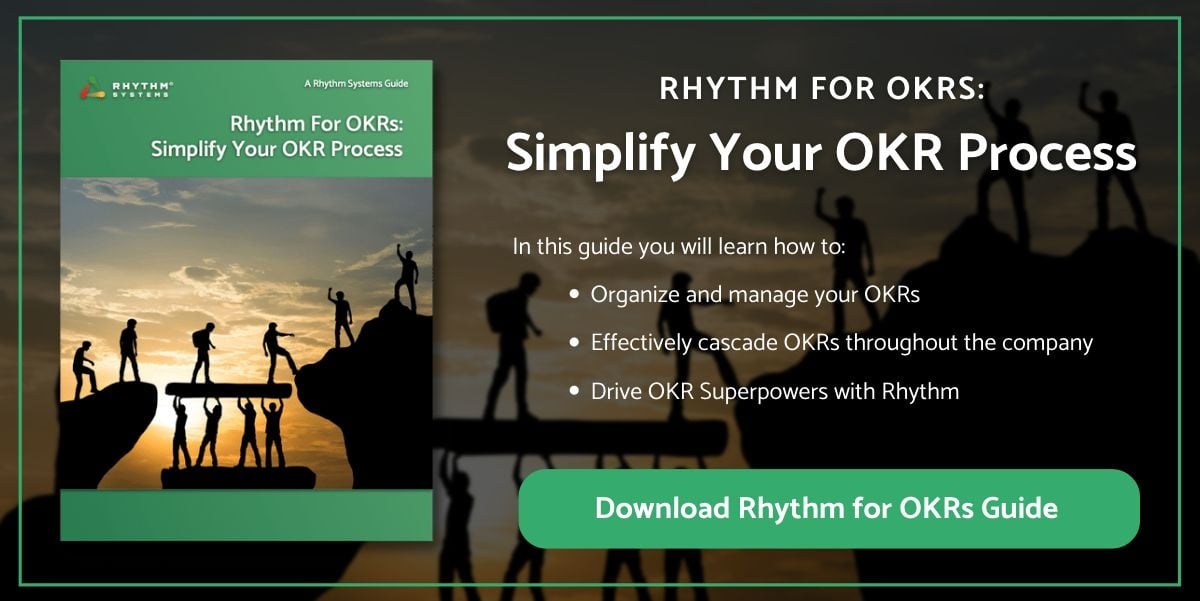OKRs are an essential part of any successful organization. They help align everyone around common goals and objectives. But what exactly are OKRs? And why do we need them? Let’s look at how OKRs work and why they’re such an effective tool for creating a high-performing team, but many don’t know how to properly write objectives and key results to effectively align teams to your 3-5 year strategic plan.
What are OKRs?
Objectives and Key Results (OKRs) are short-term goals and long-term outcomes that define success for every employee within your organization. These specific targets are broken down into smaller tasks, called objectives, and each objective is assigned a key person responsible for completing it. Every quarter, teams meet together to review progress against their OKRs. This helps ensure everyone understands where the company is headed and how they fit into achieving those goals.
In addition to helping individuals understand their roles and responsibilities, OKRs provide a framework for measuring performance. When you know what you want to accomplish, you can measure whether you’ve achieved it. For example, say you set an OKR for increasing sales revenue by 10% over the next 12 months. You could track monthly sales figures and compare them to the target number. If you see that you’re falling behind, you can adjust your plan accordingly. You want to make sure that you have some SuperGreen stretch goals to encourage your most productive employees when you write key results.
Writing great OKRs isn’t just about tracking numbers and metrics. They’re about building a strong sense of shared purpose. Employees who believe in the mission and vision of their company will perform better because they’ll be motivated to achieve their individual objectives. In fact, research suggests that companies with high levels of employee commitment outperform competitors by up to 40%.
Cascading OKRs Across Departments
Cascading OKRs (Objectives and Key Results) is a strategy that involves aligning the goals of different teams and individuals in an organization with the company's overall strategic objectives. This approach ensures that everyone in the organization is working towards the same goals and that each team's objectives contribute to the success of the company's overall mission.
To effectively cascade OKRs across an organization, it is essential to start at the top. The leadership team should set clear and measurable objectives for the company as a whole, which can then be broken down into smaller objectives for each department or team. These departmental objectives should align with the company's overall objectives and contribute to achieving them.
Once departmental objectives have been established, they can be broken down further into individual objectives for each team member. These objectives should be specific, measurable, achievable, and aligned with the departmental objectives. By cascading objectives in this way, each individual in the organization can see how their work contributes to the company's success as a whole and can work towards achieving their objectives in a way that supports the objectives of their team and the company.
What is the OKR Goal Setting Framework?
OKRs are a tool to help you achieve ambitious goals set by John Doerr when he brought OKRs to Google when working with Andy Grove. They're based on the idea that knowing what you want helps you achieve it. And they're a great way to align everyone around a common vision. So how do you set up Team OKRs in a way that aligns your team with the bigger picture? Let's look at how to write a good OKR that aligns with the company level.
First, define your objective. What do you want to accomplish? Is it revenue growth? Customer acquisition? Employee retention? Whatever it is, write down your goal. At this stage of writing an OK, focus on the larger picture of the objective of the goal that you want to achieve. In the next step, we’ll get more granular about our key results and define them in a way that leaves no room for interpretation to ensure complete alignment and transparency. Check out our full guide to implementing OKRs in your business.
Next, figure out your objectives. These are the steps you'll take to reach your goal. For example, if you want to increase customer satisfaction, your objective might be "increase customer satisfaction." Your objectives could include things like "improve conversion rates by 8%," "reduce churn by 5%," and "increase average order value by 10%."
Finally, identify key results. Key results are metrics that measure whether your organization is achieving its objectives. They show whether you're moving toward your goal. In addition, KPIs help you understand where you stand relative to your competitors. You can use KPIs to compare yourself against industry benchmarks. (Learn about KPIs vs. OKRs and how to use them both)
Marketing OKR Example
Objective:
Launch a webinar series to engage our target audience better
Key Results:
Generate 300 Sales Qualified Leads (SQL) by the end of the quarter (time-bound)
Produce $425,000 in new sales pipeline
Have an average attendance rate of 50%
Sales OKR Example
Objective:
Reach $3 Million in Annual Recurring Revenue by the end of this quarter
Key Results:
Close 5 new logo deals
Annual Recurring Revenue per deal of $600,000
Schedule 25 qualified discovery meetings
Healthcare OKR Example
A healthcare organization wanted to increase flu vaccination rates among employees. They identified three areas where they needed improvement:
Objective:
To increase Flu vaccination rates to minimize hospitalizations and sickness.
Key Results:
Increase awareness about the importance of getting vaccinated by 8%
Have 33% of staff take advantage of on-site vaccination days
Cut sick days of employees due to flu by 5%
CEO Cascading OKR Example
A CEO sets his/her own OKRs and measures them against those objectives. This helps ensure that the CEO’s priorities remain consistent throughout the organization. As such, the CEO must understand how each department works and what metrics it needs to meet.
The CEO must set OKRs aligned with the company's overall goals and needs to be cascaded. For example, the CEO might set OKRs like this:
- Increase revenue by 10% per quarter over the next 12 months.
- Reduce the cost of goods sold by 5%.
- Improve customer satisfaction by 20%.
- Achieve operational excellence.
- Grow market share by 15%.
They would roll this cascading OKR down to each team member to know exactly what they need to do to contribute to the success of your business. The individual OKRs cascade deep into the organization to create a clear picture of success; now, you must get in the Rhythm of Work to complete your strategy!
As you can see, OKRs are a great way to build a cohesive team, improve productivity, and increase overall organizational effectiveness with our OKR template and expertise in setting key results. Contact us to learn how Rhythm Systems can help you implement OKRs in your organization to increase revenue and encourage employee engagement so that your organization can realize the benefits of OKRs when setting goals.
Looking for some additional OKR examples to help get you started?
- OKR vs. KPI: What's the Difference Between OKRs and KPIs and Why You Need Both?
- OKR vs. KPI vs. MBO: What the Best Goal Types Have in Common
- Using OKRs for Your Weekly Team Meeting
- OKR Video: How to Get Started with OKRs and the Best OKR Software
- OKR Examples for Manufacturing: Measure What Matters for the Quarter
- Using Red Yellow Green Performance Indicators Examples That Are SMART
- OKR Goal Setting Steps: 5 Keys to Drive Better Results
- SMART Goal Setting Theory: To Create SMART Goals, Start With “Why”





